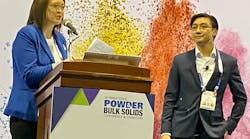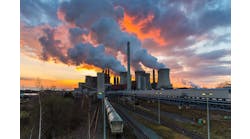I was dizzy walking through the maze of conveyors, dust-handling equipment, explosion-protection technologies, mixers and just about everything else you can imagine in the bulk solids handling industry. Last week, I attended my first Powder & Bulk Solids Conference at the Donald E. Stephens Convention Center in Rosemont, Illinois.
Being new to the industry, I didn’t know where to get started so I popped by a few random booths and attended some sessions. Here are a few notes I jotted down from the event:
Designing a Bulk Handling System
Details matter
There’s a delicate balance between overspecifying and underspecifying equipment details to vendors and engineering firms, said Michael Doby, global solids handling technology manager, Kraton Corp., during the opening-day keynote session.
“If you overspecify, you can end up not knowing about details about a specific piece of equipment because the vendor or supplier or engineering firm thinks you know everything. So then they say, ‘Hey, he knows everything he wants so we’re going to give him that.’ It’s just like a car. You have an option. … When having that discussion, if you overspecify sometimes you don’t know that maybe the vendor has developed a new widget. … The other thing is, make sure you provide a lot of information regarding the product that’s flowing through it. Sometimes key details are left off, and that’s frustrating for the engineering firm and the vendor, so it’s always good to test, test and test again. The more that you can pilot and take the time to come up with a good testing plan at the vendor, is key.”
'Don’t blindly copy and paste equipment specs’
Exxon Mobil Chemical was having some issues with a polyethylene conveying system at one of its plants. The company decided to copy much of the design from a sister site, says Melissa Lehmann, a finishing engineer for Exxon Mobil Chemical. But they didn’t realize the conveying distance was a bit shorter at the plant where they copied over the configuration. “So, the pressure drop was less. We needed less air to move the product from point A to point B. Also, the system was designed for maximum rates … but we also need to be able to turn down. So, we’re normally looking for a turndown of 60% of max rates, and that wasn’t focused on very much during design. The airflow was fixed by the compressor. We didn’t have a VFD on the compressor, so at these turndown rates, we had excess airflow that led to high conveying velocities.” This resulted in blockages in the elbows of the conveying system, blocking heat to the extruder. Similar problems occurred in a downstream pellet conveying system that led to customer complaints. Engineers ended up retrofitting the system with air blowoff valves to vent off the excess air and control conveying velocities at reduced rates. Some lessons learned:
“Don’t blindly copy and paste equipment specs from one project to another,” Lehmann says. “Make sure you understand what is truly the same and what might be different. … Also consider the full range of products and expected rates. … And don’t just focus on the max-rate case; make sure you understand what happens in a turn-down scenario.”
U.S. vs. European Combustible Dust Standards
I stopped by the Fike Corp. booth and briefly met with Brian Edwards, the firm’s explosion protection consultancy manager. He recapped a few key points from his presentation on equipment certification differences in the U.S. and Europe.
“In Europe, they rely more on notified bodies so it’s more legally enforced and it’s more regulated so there are notified authorities or agencies that will test equipment; they will certify equipment, prepare certificates. You do that in the U.S. some, but it’s more prevalent in Europe. That’s one of the key differences. Another key difference in Europe: You have equal responsibility for the end user, which is the employer or manufacturer, as with the equipment manufacturer. So they both have legal obligation, so if you sell a piece of equipment in Europe, you have more legal obligations just as equal at the manufacturing facility that the equipment is going in to. Whereas, at the U.S., the ultimate responsibility is on the factory where the equipment is going."
He added that both regions require a hazard analysis and safety strategy to protect equipment. But in the U.S., it’s a more prescriptive approach with codes that specify exactly where explosion protection is needed. European standards, or ATEX, include required hierarchies of controls, Edwards says.
“In the U.S. it’s more spotty, you might run into a local fire marshal who is going to make you get all of that in place, but it’s maybe like a 10% chance they’re going to call you out on some of this stuff. It’s a lot easier to get up and running in the U.S. – maybe not all the time because there are knowledgeable people out there, but if you’re in a rural location and the local fire marshal doesn’t know the codes you might not have all this formality in place to go.”
A few other notes …
- I also spoke briefly with Raju Dandu, director of the Kansas State University Bulk Solids Innovation Center (KSU-BSIC). He recapped some key points on his presentation about augmented reality (AR) in bulk handling applications. He discussed how AR is more practical application for bulk solids maintenance environments due to its lower cost and ease of deployment (AR can be accessed from a smartphone and requires less-extensive setup). He said AR could help organizations train technicians and guide them on troubleshooting tasks.
- The second-day keynote featured a panel of female engineers who discussed their experiences as women in a male-dominated industry. Carrie Hartford, technical sales manager and senior project engineer with Jenike & Johanson, talked about her early days in the industry working at a Chevron refinery. She discussed the challenges she faced as a young engineer working with experienced maintenance technicians and operators. Her advice to women in the field: “Acknowledge folks who have more experience than you, and when you are working on a plant design, talk to maintenance, talk to operations, get all of their ideas,” she said. “And as engineers, you’re just trying to see from an engineering perspective if that will actually work or not. And there’s a lot of respect given there. There are a lot of good people around that will help you in that. So, ask for help. Work hard.”



